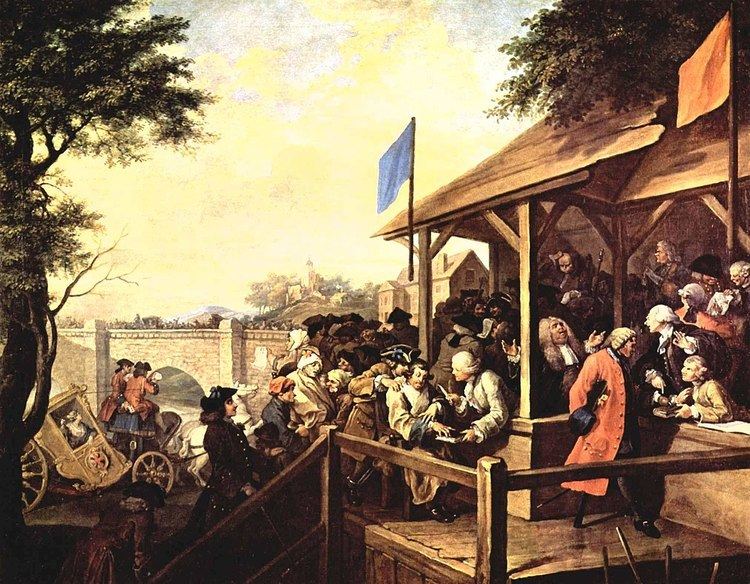 | ||
Number of members 1290–1832: Two1832–1885: Three | ||
Oxfordshire was a county constituency of the House of Commons of the Parliament of England then of the Parliament of Great Britain from 1707 to 1800 and of the Parliament of the United Kingdom from 1801 to 1885. It was represented by two Members of Parliament. In 1832 this was increased to three Members of Parliament. The constituency was abolished in 1885, being split into three single member divisions.
Contents
- Boundaries
- Elections
- Election results
- Elections in the 1710s
- Elections in the 1720s
- Elections in the 1730s
- Elections in the 1740s
- Elections in the 1750s
- Elections in the 1760s
- Elections in the 1770s
- Elections in the 1780s
- Elections in the 1800s
- Elections in the 1810s
- Elections in the 1820s
- Elections in the 1830s
- Elections in the 1840s
- Elections in the 1850s
- Elections in the 1860s
- Elections in the 1870s
- Elections in the 1880s
- References
The bitterly contested Oxfordshire election of 1754 was the main inspiration for Hogarth's famous series of paintings and engravings, The Election.
Boundaries
The constituency comprised the whole of the historic county of Oxfordshire, in the northern part of South East England. (Although Oxfordshire contained three parliamentary boroughs for part of this period – Oxford (from 1295), Woodstock (or New Woodstock) (1302–1555 and from 1571) and Banbury (from 1554) – each of which elected MPs in their own right, these were not excluded from the county constituency, and owning property within the borough could confer a vote at the county election. The Oxford University constituency was also often listed as an Oxfordshire constituency, but was non-territorial and had no effect on the right to vote in the county.)
There were minor boundary changes at the time of the Great Reform Act in 1832, when five parishes or parts of parishes were transferred to other counties while six parishes or parts of parishes were added.
In 1885 the representation of the county was changed from one three member constituency to three single member divisions. Banbury and Woodstock ceased to be parliamentary boroughs but the same names were used for two county divisions. The three new county constituencies were Banbury (or the North division); Woodstock (or the Mid division) and Henley (or the South division).
Elections
The county franchise, from 1430, was held by the adult male owners of freehold land valued at 40 shillings or more. The bloc vote electoral system was used in two seat elections and first past the post for single member by-elections. Each elector had as many votes as there were seats to be filled. Votes had to be cast by a spoken declaration, in public, at the hustings, which took place in Oxford. The expense and difficulty of voting at only one location in the county, together with the lack of a secret ballot contributed to the corruption and intimidation of electors, which was widespread in the unreformed British political system.
The expense, to candidates and their supporters, of contested elections encouraged the leading families of the county to agree on the candidates to be returned unopposed whenever possible. Contested county elections were therefore unusual. The Tory Dukes of Marlborough, dominated the county from their seat at Blenheim Palace. One seat was usually held by a Spencer, the other by a local family acceptable to the Duke. Between 1700 and 1826 there was only one contest.
Election results
Note on percentage change calculations: Where there was only one candidate of a party in successive elections, for the same number of seats, change is calculated on the party percentage vote. Where there was more than one candidate, in one or both successive elections for the same number of seats, then change is calculated on the individual percentage vote.
Note on sources: The information for the election results given below is taken from Stooks Smith 1715–1754, Namier and Brooke 1754–1790 and Stooks Smith 1790–1832. From 1832 the principal source was Craig, with additional or different information from Stooks Smith included.
Elections in the 1710s
Elections in the 1720s
Elections in the 1730s
Elections in the 1740s
Elections in the 1750s
Elections in the 1760s
Elections in the 1770s
Elections in the 1780s
Elections in the 1800s
Elections in the 1810s
Elections in the 1820s
Note (1826): Stooks Smith records that the polls were open for three days
Elections in the 1830s
Note (1837): Stooks Smith was the source for the number of electors voting. He classified Norreys, Harcourt and Parker as Tories, with Stonor as a Whig.
Elections in the 1840s
Elections in the 1850s
Note (1852): The minimum possible turnout is estimated by dividing the number of votes cast by three. To the extent that electors did not use all their three possible votes the figure given will be an underestimate of the true turnout
